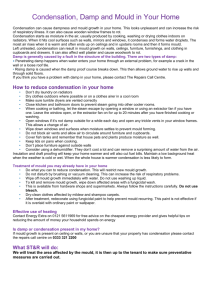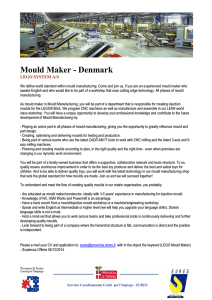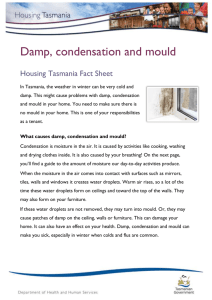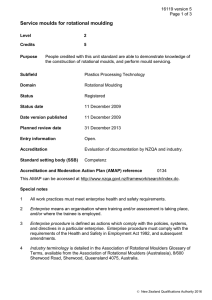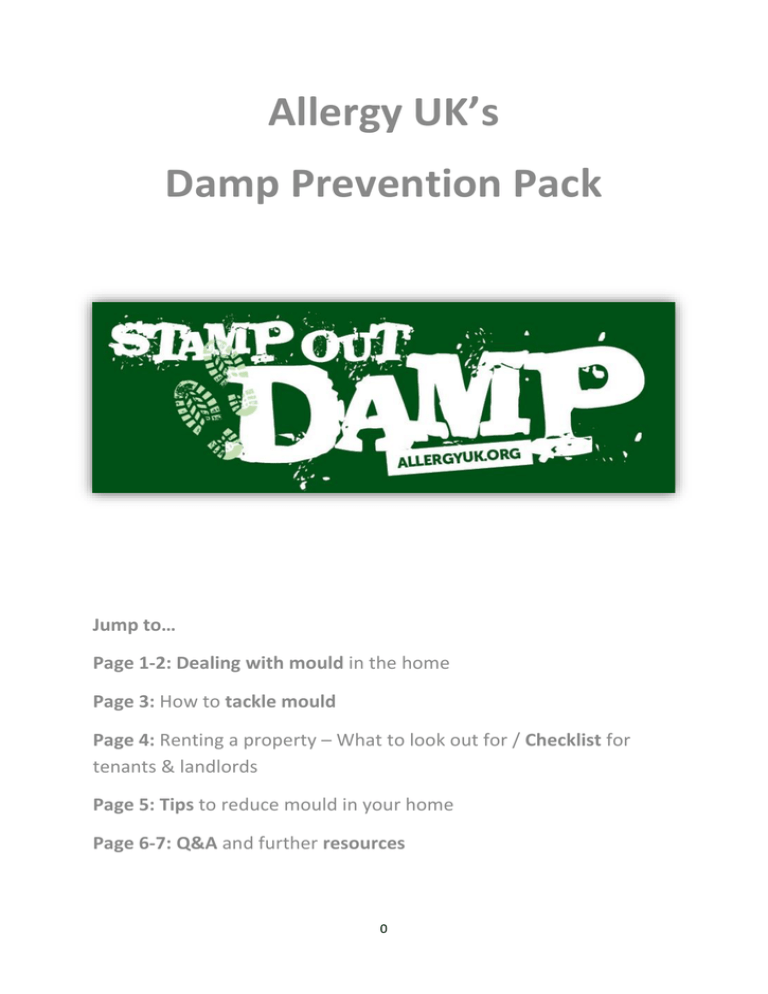
Allergy UK’s
Damp Prevention Pack
Jump to…
Page 1-2: Dealing with mould in the home
Page 3: How to tackle mould
Page 4: Renting a property – What to look out for / Checklist for
tenants & landlords
Page 5: Tips to reduce mould in your home
Page 6-7: Q&A and further resources
0
Dealing with Mould in the Home
Mould is one of the biggest causes of respiratory allergies (noses and chests), and although many
people suffer from chronic symptoms such as runny nose, sneezing, congestion, sore, puffy itchy
watery eyes and even asthma symptoms such as wheezing, very few make the link to mould in their
homes. Eczema symptoms can be made worse in those allergic to mould.
Over 30 per cent of indoor allergy symptoms are triggered by mould
(Allergy UK, Home fever survey, 2011)
Allergic conditions such as perennial allergic rhinitis (hay fever like symptoms all year round),
asthma and eczema can be caused by allergens found within the home such as those from moulds,
house dust mite or from pets. It is the spores from moulds that cause an allergic reaction and these
are prolific everywhere in our living environments.
Over a third (35%) of renting families have a problem with damp in their homes
(YouGov survey with 4,000 private tenants, Shelter, 2013)
Moulds found within the home are very common. For some people they are just a mild, unpleasant
nuisance that needs to be dealt with. But they can be a severe problem caused by a major structural
faults such as damp walls or pre-existing water damage caused by a leak or poor maintenance of the
property. If you are allergic to mould however, eradicating it from your living environment is vitally
important in helping you to improve symptoms and get your allergies under control.
Nearly one in five renters (17%) are living with a leaky roof or windows
(YouGov survey with 4,000 private tenants, Shelter, 2013)
What Causes Moulds in the Home?
Although we are exposed to them all year round levels rise during the autumn and during mild wet
weather, or in places where moisture accumulates.
To see where you can be at risk from mould and other indoor allergens around the home take a look
at our interactive allergy house – just click on the room you are interested in!
1
Condensation Areas – Bathrooms and Kitchens
Lack of ventilation and cooler room temperatures can cause
condensation and exacerbate the growth of moulds. This is a
particular problem in rooms such as the kitchen or bathroom
where cooking, tumble dryers, baths and showers produce
excessive moisture levels and make the kitchen and bathroom
danger zones. In these areas mould is commonly found in the
edges of windows or around bath and shower seals. Leaks or poor seals on kitchen units can cause
water to drip down the back of cupboards causing mould in hidden areas.
Other Areas – Lounge or Bedroom
Damp in other living areas such as the lounge or bedroom areas
are usually obvious: stains on walls or ceilings are a giveaway
sign that mould may be lurking underneath. Unfortunately, the
causes are not so easy to spot. If they are structural, such as
leaking central heating pipes, external pipes or broken guttering
or missing mortar, which has caused water to leak through the
brickwork, they will need to be investigated by a builder as a priority and should not be left. See our
tips to approach your landlord if you are renting on page 5. Even over exuberant use of carpet
cleaners can leave too much water in carpets causing the underlay to go
mouldy.
Bedding and mattress can become damp in unheated rooms and
harbour moulds. This in turn is a source of food for the house dust
mite enhancing its ability to thrive - an additional problem for those suffering
from indoor allergies.
Other Causes of Damp
Autumn and winter are the worst times due to damp and wet weather. If your home is hit by storm
damage, roofing tiles or slates can become dislodged allowing water to seep through, resulting in
damp in the loft and on ceilings. A burst water pipe in freezing weather can cause severe water
damage and if it is not dried out sufficiently it can lead to damp areas under the floor boards. Faulty
damp proof courses are often the cause of serious rising damp issues.
Outdoor storage areas that aren’t heated such as the garage or
garden shed are prime environments where mould can thrive,
as is the soil on houseplants.
The musty smell given off by mould spores is the most obvious
sign there is a mould and damp problem in the living
environment. Unfortunately, living with this problem can make
you oblivious to the smell which means you are less likely to realise there is a damp problem in your
home. Damp can cause a musty smell on clothing, which you may not notice yourself.
2
What can you do to tackle mould?
You will need to tackle the problem differently depending on whether it is a little bit of mould in the
bathroom caused by poor ventilation and condensation, or a larger issue caused by structural
damage or poor maintenance. How you deal with the issue will be affected by whether you are a
home owner (living in your property) or whether you are in rented accommodation. Whatever your
circumstances are, it should be dealt with and not ignored or left untreated. Damp can have a
serious effect on you and your family’s health.
Next Steps for Homeowners
If you are in your own home you can use our tips on page 5 to help reduce
moulds in your home, but it is also worth contacting a builder, surveyor or
specialist damp company to investigate the cause if you think it may be a
more serious problem. You may be covered for water damage from a burst
pipe in your home by your house insurance but not for upkeep and
maintenance, so best to check with your insurance company.
If you are purchasing a property it is essential to have a full survey by a chartered surveyors. With
one of the following qualifications: Assoc RICS; MRICS; FRICS.
Next Steps for Renters
If you are living in rented accommodation you can tackle the internal mould by making small
changes to your daily routine when cooking, and washing and drying clothes. If it is a structural
problem you should contact your landlord. This may be your housing association, local council,
private landlord or lettings agent. If you are a university student you can also contact your student
advice centre and speak to your university’s accommodation officer or student lettings agent.
Landlords have an obligation to keep their properties in good repair.
They may be unaware of a leak or structural fault that could be easily
rectified if caught quickly, which is why it’s important to contact
them immediately if you have a damp problem. It is in their best
interest to keep their property in good repair. Having a good
relationship with your landlord and keeping them up-to-date with
any problems is advisable. Contact them in writing as soon as you
realise there is a problem and keep a record of the contact you have made. What seems a minor
issue such as a small leak in your roof, could quite quickly become a large, expensive problem for
your landlord and a health risk to you as a tenant.
You will be able to refer to your tenancy agreement to ensure you know exactly what are your rights
and conditions. Your local Citizens Advice Bureau (CAB) may be able to help and advise on your
particular case.
3
Renting a Property – What to Look Out For
You may have found your ideal home but before you start
planning your house move you should check whether
there is mould lurking beneath the surface. Read our top
tips to help you identify mould and damp on a visit to the
property before you sign on the dotted line.
Checklist for Tenants
When looking at the property make sure that you check for any signs of water damage, such
as stains on ceilings or walls which may indicate a mould problem
Does the accommodation smell ok? Are there air fresheners plugged in which could be
covering a damp smell? If it has a musty smell or feels cold it might just mean that the
accommodation hasn’t been used for a while and needs a good airing, but it probably means
that there is damp somewhere in the property
Check bathrooms, cupboards, around doors and windows for signs of black mould
Check that all the wallpaper is dry and well stuck down. If it is loose and bubbling away from
the walls there could be damp and mould underneath
Can you open windows for ventilation?
Is there somewhere that you can dry your washing such as a laundry room or balcony or
garden? Drying over a radiator or in the bathroom creates condensation.
Check who is responsible for repairs and maintenance
Only sign a tenancy agreement once you are happy with whose responsibility it is to take
care of specific maintenance on the property.
If you are a landlord, or you are a tenant who would like to give your landlord some further advice
and resources, take a look at our checklist:
Checklist for Landlords
Provide areas where washing can be dried such as laundry rooms, or provide outside vented
tumble dryers or a covered area and a washing line if there is a garden
Set up an agreement with your tenants that states what is acceptable within the property to
help prevent damp problems or offer advice on preventing damp in your property
When meeting new tenants, help them to be aware of the areas in the home which are
prone to developing mould such as the bathroom and kitchen, and advise them how to
avoid mould by using simple tips on page 5.
Make periodical checks to the roof, guttering, brickwork and damp courses
Make sure airbricks are kept clear to enable good ventilation
Contact the National Landlords Association (NLA) for further information (see our
resources).
4
Top Tips to Reduce Mould in Your Home
Moulds flourish in damp environments; therefore one of the best ways to prevent their
growth is VENTILATION
Thorough cleaning of the kitchen, bathroom and utility room with subsequent ventilation of
these areas will help prevent mould growth. Pay particular attention to walls behind kitchen
units and cupboards; the lack of ventilation often means that excess mould grows in these
areas
Use extractor fans and cooker hoods vented outside
Open windows and close internal kitchen and bathroom doors when cooking, showering or
bathing to prevent steam entering other rooms. Keep bathroom surfaces dry. Do not hang
wet clothes inside or over radiators
Open the bedrooms window at night for air circulation, moisture vapour from our breath
and bodies increases the bedroom humidity
Do not let food decay and remove mouldy fruit from fruit bowls and the refrigerator. Clean
and thoroughly dry problem areas such as refrigerator seals
Clean mould from window frames using a toothbrush and a weak solution of bleach and
warm water
Keep surfaces dry of condensation
Do not hang clothes in damp cupboards or pack clothes too tightly in
wardrobes. Leave wardrobe doors ajar to ventilate
the clothes
Make sure that your tumble dryer is vented outside
during use, or use a condenser-dryer. Do not dry
damp clothing indoors
Get rid of old foam pillows and mattresses
Strip wallpaper from damp walls. Tackle any areas of dampness on walls etc
Remove piles of old newspapers
Keep houseplants to a minimum and change the topsoil regularly
Do not use humidifiers
If using a dehumidifier, keep indoor humidity at 50% or less. Empty and clean the reservoir
daily
Avoid using paraffin heaters and bottled gas heaters - they generate large amounts of
moisture
Solutions are available which eradicate moulds and deter their growth on windows,
bathrooms and refrigerators
Carpet harbours house dust mites and mould spores. Choose an Allergy UK approved
flooring. If you need to keep your carpet, use a vacuum with HEPA filtration
Using an air purifier in the bedroom can help to trap airborne allergens
For severe mould infestation, contact the environmental health department of your local
authority for advice and assistance.
5
Q&A
What should I do if I think I am allergic to mould?
First and foremost you need to assess whether the symptoms you are
experiencing are caused by an allergy to mould. Complete our symptoms checker to see
if you need to visit your GP for further advice.
If your GP suspects that your symptoms are caused by an allergy to moulds or another
allergen found within the home, he can arrange for you to see a specialist doctor to
confirm this allergy.
How does living with mould affect you?
Mould releases spores and it’s these spores that cause reactions in people allergic to
mould. Spores are microscopic particles released by moulds in their thousands into the
atmosphere. When in contact with skin or breathed in through the airways it can cause
symptoms such as itchy eyes, eczema, rhinitis and asthma. It can also you make you
feel tired, which is caused by your immune system battling against mould spores.
What long term problems can it cause you?
People who develop allergies may be likely to develop reactions to other allergens over
time. Asthma, rhinitis and eczema are long term health conditions. To find out whether
your asthma is due to allergy you need to have an allergy skin prick test or blood test.
You can access this either through your GP or by being referred by your GP to a
specialist allergy centre.
Is it very common?
Yes, particularly in people with chronic asthma and rhinitis. Many people do not know
that mould spores are the cause of their symptoms. Unless a patient has received
diagnosis from a recognised medical professional it’s not possible to confirm that their
asthma, rhinitis and eczema are caused by mould spores. Some sufferers are properly
diagnosed but many people simply do not reach a medical professional qualified or
experienced in allergy, or realise their symptoms are caused by mould spores in the
home.
Why is Allergy UK launching the ‘Stamp Out Damp’ campaign?
We are raising awareness about the link between allergic conditions and damp in the
home so people can identify whether their symptoms are allergy-related and get
further help. We know from recent research (Shelter, 2013) that those in rented
accommodation could be living in damp conditions, unaware of serious health
6
implications. ‘Stamp Out Damp’ encourages people to assess their living environment and
implement simple changes around the home to make a difference.
How can I help people to ‘Stamp Out Damp’ and spread the word?
Download the poster and place on a noticeboard at your university, work, school,
college, local community centre as well as your local GP surgery/health centre and
library.
Share our ‘Stamp Out Damp’ information on our facebook page to your friends or tweet
us using #StampOutDamp - Follow us on twitter
You can also help but letting your friends, family and colleagues know about ‘Stamp Out
Damp’ and encourage them to visit our website: www.allergyuk.org to download
factsheets or call our helpline if they need support on: 01322 619898.
Further Resources
Citizens Advice Bureau:
http://www.citizensadvice.co.uk/
NLA (National Landlords Association):
www.landlords.org.uk
NUS (National Union of Students):
www.nus.org.uk
Shelter:
http://england.shelter.org.uk/get_advice/repairs_and_bad_conditions/disrepair_in_rented_accom
modation/repairs_in_private_lets/contacting_environmental_health
Which: http://www.which.co.uk/home-and-garden/home-improvements/guides/dealing-withdamp/whats-the-best-way-to-deal-with-damp/
Indoor Allergy Week 2013 is supported:
© 3M 2013. All rights reserved. 3M and Filtrete are trademarks of 3M.
7

